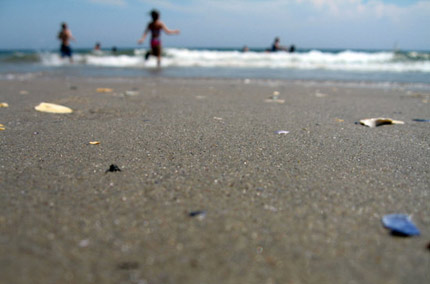New Bills: From Saving Energy to Preventing Choking
While the City Council continues to focus on construction hazards in the city, individual council members have kept their eye on other legislative prospects. They have offered common sense solutions to quality of life issues, proposals to conserve energy in the summer and various offbeat initiatives likely to flounder in City Hall.
This is just a sampling of the City Council bills introduced in the last month.
Family Leave Act
Nationwide, less than 10 percent of workers get paid time off to care for sick family members, according to the Working Families Party. Though the federal Family and Medical Leave Act offers 12 unpaid weeks, about two thirds of those eligible do not take the time because they cannot afford to, according to a study by the U.S. Department of Labor.
Letitia James, the only council member elected on the Working Families Party line, introduced legislation (Intro 805) to give private employees 12 paid weeks off to care for sick family members. The bill would cover a range of relatives, from nieces to spouses. The party has proposed a similar measure on the state level.
James, who cares for her mother, said she has the discretion to leave work to take care of a family emergency. Others, especially those with both parents and children to care for, do not.
"I wanted to provide some relief for baby boomers and for others who are just juggling family and work," said James.
According to the bill, private employers would be able to use accrued sick time or disability to pay for the employees' time off. James said supporters have not yet studied the cost of the bill. Unlike the federal unpaid act, which applies to companies with more than 50 employees, James's bill does not have a restriction on the size of the business.
The legislation would also prevent employers from retaliating against employees, by terminating their positions, for example, because they take leave.
On the state level, the legislation would be funded by increasing disability insurance.
California, New Jersey and Washington State are the only states that offer paid family leave.
Sustainable Street Lamps
To reduce the city's consumption of energy, Councilmember Jessica Lappin of Manhattan introduced legislation (Intro 806) requiring the city replace its current street lamps with light-emitting diode street lamps.
Diode street lamps can reportedly reduce energy consumption by 70 percent. Other cities are testing similar technology.
Within one year of the bill's potential approval, according to the legislation, all of the city's street lamps would have to use diode bulbs.
Dangerous Foods
Approximately two years ago, a young child in Brooklyn choked to death on a grape. To increase awareness of choking hazards, Councilmember Domenic Recchia introduced legislation (Intro 807) requiring the labeling of food that are choking hazards.
Similar legislation was introduced in Albany in 2004 after a 3-year-old choked to death on a popcorn kernel.
Under the bill, the Department of Health and Mental Hygiene would compile a list of foods that present a significant choking hazard to children ages 5 and below. Those foods would need to have a warning label.
A spokesman for Recchia said the Department of Consumer Affairs would be charged with enforcement. It is likely, he added, storeowners would be responsible for ensuring dangerous foods were labeled, not farmers or national vendors.
A cost analysis of the bill has not yet been completed.
Tracking the Emotionally Disturbed
After a series of incidents late last year involving mentally or emotionally disturbed individuals creating disruptions or acting violently, which in one incident led to the shooting of an unarmed man by police, calls for action trickled in from communities.
In response, Councilmember Peter Vallone introduced legislation (Intro 799) calling for the creation of a database, to be overseen by the New York Police Department and the Department of Health and Mental Hygiene, that would keep tabs on the "emotionally disturbed."
The database would include, at a minimum, the name, address and nature of the incident involving an "emotionally disturbed" person. It would file incidents where individuals were transported to a hospital.
According to the legislation, the police department made more than 87,000 radio runs in 2007 that involved an "emotionally disturbed" person.
A Vallone spokesperson said the database would help police and health officials spot trends and identify people who needed help.
Clean Elections
After an overhaul of the city's campaign finance legislation last year, Councilmember Tony Avella is looking to take the city's law one step further by decreasing limits to receive public financing.
Under the bill (Intro 803), which Avella has titled the "Clean Elections Law," City Council candidates would have to raise just $2,500, consisting of small donations from $5 to $100, to qualify for $100,000 in public financing for the primary and an additional $100,000 for the general election. The bill would also limit contributions that could be matched with public dollars to less than $100.
The legislation reduces overall spending caps for every city office and lowers public financing requirements for all citywide offices. In a prepared statement, Avella said the restrictions would reduce the influence of special interest money, which flood campaigns with large, bundled donations.
"Under the current system the playing field isn't leveled," said Avella in a press release. "It's actually tilted."
Under the bill, which has garnered one other sponsor, Councilmember Joseph Addabbo, City Council candidates would also have to commit to two debates.
Delaying Health Fines for Nonprofits
Under a bill introduced by Councilmember Vincent Gentile (Intro 791) nonprofits, including religious and cultural groups, would get extra time to remedy health code violations before paying a fine.
"The intention is not to exempt these organizations from following the law," said the councilmember's budget and legislative director, John Buckholz. "It's to reduce the financial burden that’s imposed on them."
Yellow Curb Cuts
While some parts of the city are covered with illegal curb cuts that slice away front lawns, Councilmember Michael McMahon wants to protect the legal ones.
Under a bill (Intro 797) introduced by McMahon, property owners would be allowed to paint their curb cuts yellow. It would be a clear warning sign to other parkers not to block driveways.
Taking the LEED on Capital Projects
Councilmember Joel Rivera introduced legislation (Intro 798) requiring capital projects comply with most standards of the U.S. Green Building Council's Leadership in Energy and Environmental Design (LEED) Green Building Rating System, an accredited measurement of green building.
Any project that receives partial or full funding from public coffers and costs more than $5 million would have to comply with some portion of the standards. As a project's cost increases, a contractor would have to comply with more standards under the bill.
Energy Efficiency Disclosure
A bill (Intro 800) introduced by Councilmember Al Vann would require any owner of a condominium, co-op or one to four family home notify prospective buyers of the property's energy efficiency, including the monthly cost of the electric bill for the previous two years.
Transparency at Children's Services
A bill (Intro 804) introduced by Councilmember Bill de Blasio would require the Administration for Children's Services submit quarterly reports to the City Council on day care closures and the average time it takes, from application to placement, for a child to receive daycare.
Â
On the Beaches
ALSO:
The Bronx's Secret Shore:
Unbeknownst to the vast majority of its residents, the Bronx serves as home to a number of private beach clubs.
Whistle While You Work:
The job is outside, you wear a bathing suit -- and the city usually has openings.
Coney Island Roller Coaster:
The fight over how to develop the famed beach continues.
Urban Riviera?
New York's beaches offer surf and sun without a long drive on the Long Island Expressway. But how safe and clean are they?
New York's Best and Worst Beaches:
They are both on Staten Island but there the similarities end.
With eight public beaches in the city, New Yorkers do not have to venture far from home to smell the salt air and sunblock. But does our Urban Riviera really offer a respite for residents fed up with the cement landscape and longing for fresh ocean air and soft sea breezes? And how clean and safe are the beaches -- seven city and one federal?
Gotham Gazette's audio slide presents words and images from some of the city's most popular beaches, as beachgoers critique the scene around them, from litter to accessibility to jellyfish.
To view the audio slide show, go here.
Beach Map: Sounds from the Surf
Call it the heat island effect or the draw of fun in the sun, the desire for sand between your toes and salt in your skin hits many of us during the summer. While some New Yorkers spend their days drowning in traffic on the way to the Hamptons, others recognize we have seven city public beaches and many more private facilities right here in the five boroughs.
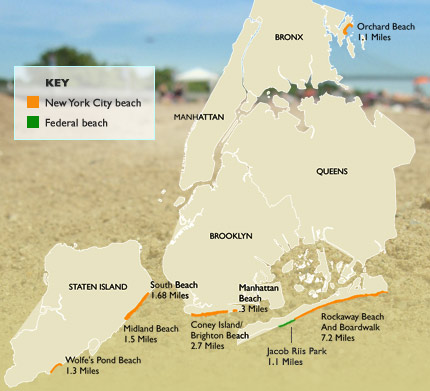
TAKE YOUR PICK:
There's the vivacious and crowded Coney Island or its more subdued neighbors, Brighton Beach and Manhattan Beach.
Head to Rockaway Beach in Queens and dip your toes in the Atlantic where few remnants of New York City, besides the A train, remain.
Feeling adventurous? Take the ferry, then a train and maybe a long walk (see related story) on Staten Island, which boasts three city beaches: Midland and South Beaches as well as Wolfe's Pond Beach.
Then there's Orchard Beach, tucked into Pelham Bay Park, the only public beach on Long Island Sound.
If none of those satisfy, meander through Jacob Riis Park, a federal beach in the city, or check out the many private beaches that line our urban coastline.
Sounds from the Surf
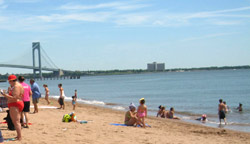
South Beach, Staten Island
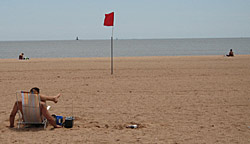
Midland Beach, Staten Island
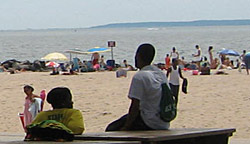
Manhattan Beach, Brooklyn
Â
New York's Best and Worst Beaches
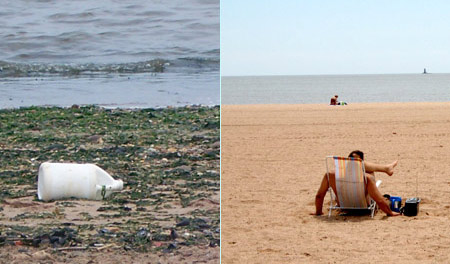
ALSO:
Touring the Urban Riviera:
An audio slide show of New York's public beaches.
The Bronx's Secret Shore:
Unbeknownst to the vast majority of its residents, the Bronx serves as home to a number of private beach clubs.
Whistle While You Work:
The job is outside, you wear a bathing suit -- and the city usually has openings.
Coney Island Roller Coaster:
The fight over how to develop the famed beach continues with fate of the famed rides and amusements at stake.
Urban Riviera?
New York's beaches offer surf and sun without a long drive on the Long Island Expressway. But how safe and clean are they?
Midland Beach and Wolfe's Pond Beach are both on Staten Island and operated by the city's parks department. Roughly the same size, they both stretch about one and a half miles along the shoreline. And on a Monday afternoon in July, the two beaches each boasted one lone swimmer bobbing up and down amid the waves. The similarities ended there, according to New Yorkers for Parks. In its 2007 Report Card on Beaches, the group ranked Midland Beach the best in New York City. Wolfe's Pond Beach came in last.
New Yorkers for Parks, an independent watchdog group, began releasing its Report Card on Beaches in 2003. The rating assesses the seven beaches controlled by the parks department, comparing them to one another as well as from year to year. The group grades beaches on four features: quality of shoreline and condition of pathways, bathrooms and drinking fountains.
In the 2007 rankings, Midland Beach was the only beach that received an overall ranking of "Satisfactory." Four other beaches were deemed "Challenged" and the remaining two, including Wolfe's Pond, were "Unsatisfactory." (The other unsatisfactory beach was Coney Island.)
An Eyewitness Account
Curious about the best and worst beaches in the city -- and how such disparate facilities could be in such close proximity to each other-- Gotham Gazette decided to investigate.
The first thing we discovered was that the age-old mantra of life being about the journey and not the destination is painfully true when heading to Staten Island's beaches. Without a car, there is simply no easy way to access the beaches. Both beaches are at least a 20-minute walk from the nearest express bus stop or the Staten Island Railroad.
Midland Beach
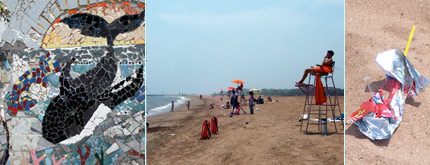
Midland Beach had the highest performance rating of any shoreline, and the report noted minimal litter and debris along the beach. The Report Card found the pathways a minor challenge, facing overgrowth and warping or breaking of the asphalt. The bathrooms received a grade of 65 percent due to general disrepair. Drinking fountains at Midland Beach ranked best of those at any beach, though they still only received a "D" because of poor structure and repairs.
Upon arrival at Midland Beach, it was quickly apparent as to why it scored well. With over 300,000 visitors a year, the beach offers an impressive expanse of well maintained somewhat orange sand leading down to the water. Sturdy woven plastic mats stretch across the sands leading to the water, making the beach easily accessible by wheelchair. Families push strollers down the mats and then lift them onto a nearby spot in the sand.
A clearly marked bike path and walkway border the beach. The promenade features benches and drinking fountains, as well as a fountain with a prominent sculpture of a sea turtle where children leap about and dodge the squirting streams of water. The park includes playgrounds, a baseball diamond, more benches and shaded areas, among other amenities.
"Minimal" presence of litter, as the Report Card phrases it, can be a relative term, and there were wrappers and plastic bottles in the sand nearest to the water. The rest of the area was cleaner, though, and trashcans were not overflowing. Ten lifeguards surveyed the scene, and most families clustered around their towers. The sound of laughter and children shrieking things like "I see a whale!" followed by "No, it's a shark!" carried along the light breeze, as did a slight fishy odor.
The bathrooms were a bit dark and wet, but each stall had toilet paper, and the sink area had soap and a working hand dryer. The showers were also in good condition, and there was a covered changing area. Drinking fountains were few and far between, and seemed to be in fairly poor condition.
Peter, a lifeguard, said that the beach is frequented mostly by families and gets especially busy on the weekends. He cited the murkiness of the water as the area's only drawback.
That murkiness did not seem to concern Mona Lozah and her three children. A resident of Staten Island, she said that she prefers Midland to the nearby South Beach or Coney Island Beach, the other two parks department beaches she has visited. When asked why, she said, "Parking!" and gestured to the massive and almost empty parking lots. She also praised the beach for its cleanliness, lack of insects and family friendliness. Her kids, totally absorbed in their construction of a sand castle, seemed to agree.
Wolfe's Pond Beach
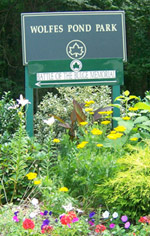
No laughter rang across Wolfe's Pond Beach. In fact, there were no sounds on a July day except the wind, the waves and a circling police helicopter. The entire shore was littered with seaweed, shells and driftwood, as well as broken glass, empty alcohol bottles, a gallon jug of bleach, an old tire, and a rusting metal folding chair. The smell of fish was far more than slight. We could not find the two informal ramps that the parks department Web site says can be used for wheelchair access.
While the Report Card noted that the section of shore open to the public at Wolfe's Pond was well maintained, it cited overwhelming debris, including safety hazards such as glass, as the reason for the shoreline's failing grade. The pathways were rated on par with the rest of the beaches, but New Yorkers for Parks found the bathrooms were closed and locked, accounting for their failing score. There are no drinking fountains on the beach, though there are plenty to be found in the adjoining Wolfe's Pond Park.
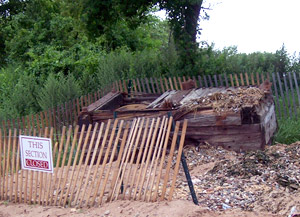
Three lifeguards were on duty for the miniscule stretch of beach open for swimming. Pointing to the piles of debris covering the sand near the water, the lifeguards, who would not give their names, said that beachgoers needed to wear shoes or water shoes at all times for safety. When asked if people swim in the water, they replied "Unfortunately." On its Web site, the parks department mentions the large amount of seaweed at the beach, but that seemed to be an understatement as each wave turned over fresh mounds of green leafy plants.
Asked to name the best part of the beach, one lifeguard cited the lifeguards. More seriously, another replied, "The park."
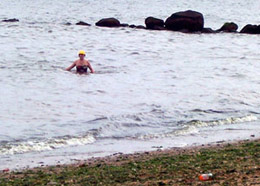
Sure enough, walking up the worn wooden steps to the park seemed like entering another world. Manicured lawns led into playgrounds and picnic areas where families barbecued. Teenagers skated around a roller hockey rink or swatted balls at the tennis courts. Clean drinking fountains and bathrooms abounded.
Better Beaches?
In response to reports on conditions at Wolfe's Pond and other beaches, the parks department cites statistics from its own Parks Inspection Program, which, it says, shows conditions have been improving. "By every measure, New York City's beaches are in better shape now than at any other time," a spokesperson said. However, the department acknowledges that "litter on public beaches is a primary concern" and asks the public to help.
Our visits did show improvement at the Staten Island beaches since last year's Report Card was compiled. Midland Beach had been using one bathroom as a storage space for desks, according to the report. This year, there was no furniture to be found.
New Yorkers for Parkers marked down Wolfe's Pond Beach for not having signs barring swimming in closed areas. This year, behind some trees, you could read a sign that said "Swimming Prohibited: No Lifeguard on Duty."
Beachgoers will more than likely obey.
Â
